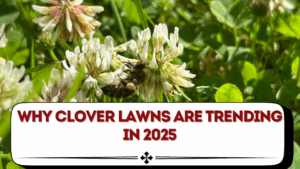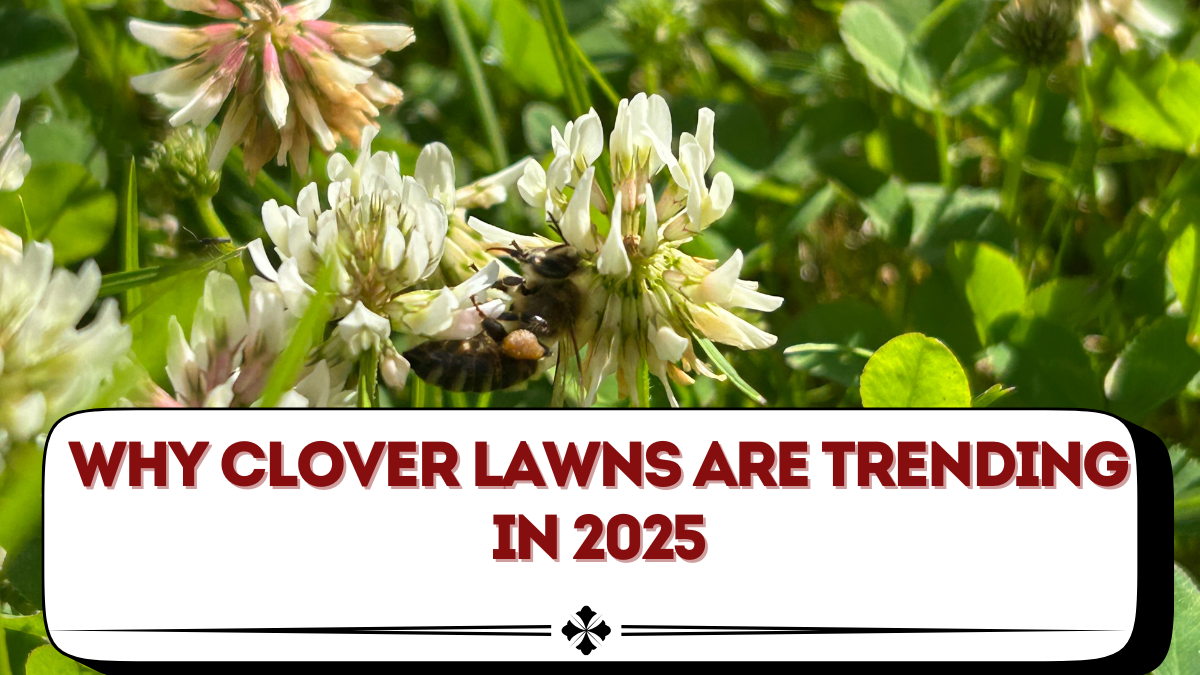The image of a perfect lawn has long been tied to uniform green grass, trimmed neatly and watered regularly. But in 2025, a growing number of homeowners are abandoning this high-maintenance tradition in favor of clover lawns. The clover lawns trend is taking off worldwide as people realize that clover is not only eco-friendly but also attractive, resilient, and inexpensive to maintain.
Clover lawns offer soft greenery, natural fertility, and blooms that attract pollinators. They are more drought-resistant than typical turf and require less mowing, making them a sustainable choice for modern yards. This article explores why clover lawns are gaining momentum, how to establish them, and the benefits they bring compared to grass-only lawns.

Why Clover Lawns Are Becoming Popular
Traditional grass lawns demand high water use, constant fertilization, and frequent mowing. Clover, on the other hand, thrives with little effort. The global push toward eco-conscious living, combined with rising water costs, has made clover a standout choice for homeowners who want sustainability without sacrificing beauty.
Another factor fueling the trend is biodiversity. Clover blooms provide nectar for bees and butterflies, supporting declining pollinator populations. At the same time, clover enriches soil naturally by fixing nitrogen, which reduces the need for chemical fertilizers.
Benefits of Clover Lawns
Switching to a clover-based lawn comes with multiple advantages that appeal to both homeowners and the environment.
Key benefits include:
-
Low Maintenance – Requires less mowing than grass.
-
Water Efficiency – Clover tolerates drought and stays green longer.
-
Natural Fertilizer – Enriches soil by fixing nitrogen, reducing fertilizer needs.
-
Soft Surface – Feels comfortable underfoot for children and pets.
-
Pollinator Friendly – Flowers attract bees, butterflies, and beneficial insects.
-
Resistant to Weeds and Pests – Clover’s dense growth suppresses weeds naturally.
With these benefits, it’s easy to see why clover lawns are gaining popularity in 2025.
Clover vs Traditional Grass Lawns
| Feature | Clover Lawn | Grass Lawn |
|---|---|---|
| Water Use | Low | High |
| Fertilizer Needs | None (self-fertilizing) | Regular feeding required |
| Mowing Frequency | Few times per year | Weekly during growth season |
| Pollinator Support | High | Very Low |
| Weed Resistance | Strong | Weak |
| Softness | Soft and cool | Variable depending on species |
This comparison shows that clover lawns outperform grass in nearly every category, making them a more sustainable and practical choice.
Types of Clover for Lawns
Not all clover is the same, and selecting the right variety can determine the success of your lawn.
Popular clover varieties include:
-
White Clover (Trifolium repens) – The most common choice, low-growing and resilient.
-
Microclover – A smaller variety that blends well with grass for a uniform appearance.
-
Red Clover (Trifolium pratense) – Taller, with showy flowers, ideal for meadows or mixed lawns.
Microclover is especially popular in urban settings because it maintains a neat, compact look while offering all the ecological benefits.
How to Establish a Clover Lawn
Creating a clover lawn is simple, affordable, and suitable for both new lawns and conversions.
Steps to establish include:
-
Prepare the Soil – Loosen compacted soil and remove weeds.
-
Choose the Seed Mix – Use clover alone or mix with grass for a blended look.
-
Sow Seeds Evenly – Spread seeds by hand or with a spreader, then lightly rake.
-
Water Until Established – Keep soil moist for 2–3 weeks until clover germinates.
-
Minimal Maintenance – Once established, mow occasionally to control flowering height.
Clover spreads quickly and fills gaps, making it one of the easiest low-maintenance lawn alternatives.
Challenges of Clover Lawns
While clover offers many advantages, it also comes with a few considerations.
-
Flowering and Bees – Some homeowners may dislike bees around lawns, though they are generally harmless.
-
Shorter Lifespan – Clover may thin out after a few years, requiring reseeding.
-
Not Ideal for Heavy Traffic – Grass handles heavy play areas better than clover alone.
-
Seasonal Appearance – Clover may go dormant in extreme heat or cold, leaving patchy spots.
These challenges can be minimized by mixing clover with grass or choosing microclover for more durability.
FAQs
Why are clover lawns trending in 2025?
Clover lawns are trending because they require less water, mowing, and fertilizer while supporting pollinators and improving soil health.
Do clover lawns attract bees?
Yes, clover flowers attract bees, which is beneficial for biodiversity. However, mowing before bloom can reduce bee activity in play areas.
Can clover be mixed with grass?
Yes, microclover blends well with grass, creating a durable, green lawn that looks uniform but requires less care.
Are clover lawns good for pets?
Clover is soft and safe for pets, though areas with heavy traffic may benefit from mixing clover with grass.
How long does a clover lawn last?
Clover lawns may thin after 2–3 years, but reseeding can easily restore density.
Conclusion
The clover lawns trend is transforming how people think about their yards. With benefits like low maintenance, water efficiency, natural fertilization, and pollinator support, clover offers a sustainable and beautiful alternative to traditional turf. While not without challenges, its resilience and ecological value make it one of the top lawn solutions in 2025. For homeowners looking to save time, money, and resources while contributing to a healthier environment, clover lawns are the future of eco-friendly landscaping.
Click here to know more.
